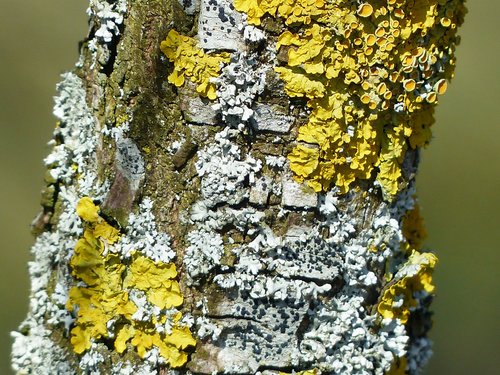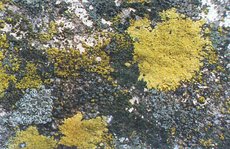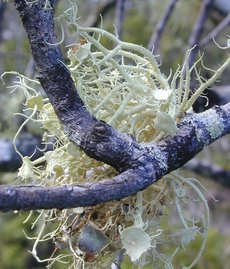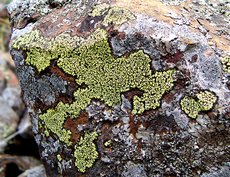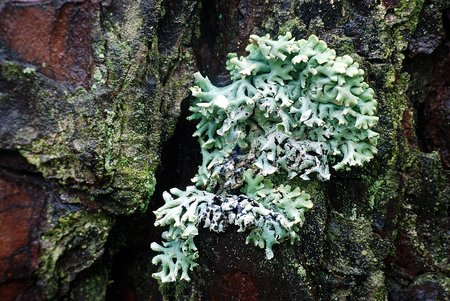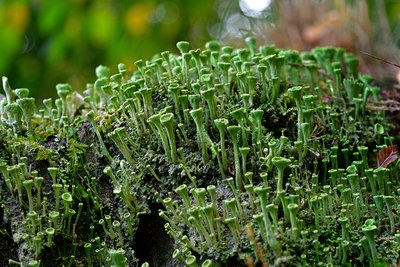Lichen
|
|
Lichens are symbiotic organisms made up by the association of microscopic green algae or cyanobacteria and filamentous fungi. Lichens take the external shape of the fungal partner and hence are named based on the fungus. The fungus most commonly forms the majority of the lichen's bulk, though in filamentous and gelatinous lichens this may not always be the case. The lichen fungus is typically a member of the Ascomycota— rarely a member of the Basidiomycota. Some lichen taxonomists place lichens in their own division, the Mycophycophyta, but this practice ignores the fact that the components belong to separate lineages.
The algal cells contain chlorophyll, permitting them to live in a purely mineral environment by producing their own organic compounds (see photosynthesis). The fungus protects the alga against drying out and provides it with minerals obtained from the substratum. If a cyanobacterium, such as in Terricolous Lichens, is present this can fix nitrogen, complementing the activities of the green alga.
| Contents |
Morphology and structure
Lichens live on various surfaces: soil, trees, rocks, and walls. They are often the first to settle in places lacking soil, constituting the sole vegetation in some extreme environments such as found at high mountain elevations and at high latitudes. Some survive in the tough conditions of deserts, and others on frozen soil of the arctic regions. Some lichens have the aspect of leaves (foliose lichens); others cover the substratum like a crust (crustose lichens); others adopt shrubby forms (fruticose lichens); and there are gelatinous lichens (see lichen forms below). The form of a lichen is generally determined by the fungus, though the photobiont may also influence it in some cases. Dead or dying photobiont cells may be digested by the fungus, but for the most part the photobiont remains healthy during the functional period of the symbiosis with the exchange of nutrients being "voluntary".
When seen under magnification, a section through a typical foliose lichen thallus reveals four layers of interlaced filaments (fungus). The upper layer is formed by densely agglutinated fungal hyphae building a protective outer layer called the cortex. Cyanobacteria may be held in small eruptions of or under the surface called cephalopodia. Beneath the upper cortex is an algal layer composed of algal cells embedded in rather densely interwoven fungal hyphae. Each cell or group of cells of the photobiont is usually individually wrapped by hyphae and in some cases penetrated by an haustorium. Beneath the algal layer is a layer of loosely interwoven fungal hyphae without algal cells. This layer is called medulla. Beneath the medulla the bottom surface resembles the upper surface and is called the lower cortex, consisting of densely packed fungal hyphae. The lower cortex often bears structures, such as rhizinae or a tomentum, serving to attach the thallus to the substratum on which it grows. Lichens also sometimes contain structures made from fungal metabolites, for example crustose lichens sometimes have a polysaccharide layer in the cortex. Although each lichen thallus generally appears homogenous, it may consist of several different species of fungus and photobiont living together.
Reproduction
Lichens most frequently reproduce asexually, either by vegetative reproduction or through the dispersal of diaspores containing algal and fungal cells. Soredia (sing. soredium) are small groups of algal cells surrounded by fungal filaments that form in cavities called soralia, which open when the lichen dries or surrounding tissues die and release the soredia to be dispersed by wind. Another form of diaspore is isidia, elongated outgrowths from the thallus that break off for dispersal. Fruticose lichens, in particular, can easily fragment. Due to the relative lack of differentiation in the thallus, the line between diaspore formation and vegetative reproduction is often blurred. Many lichens break up into fragments when they dry, dispersing themselves to resume growth when moisture returns.
Lichens also reproduce sexually in a manner typical of fungi, forming fungal and algal "propagules" that following germination must meet with a compatible partner before a functional lichen can form. This is generally not a common means of reproduction for most lichen, though it is more common in basidiomycetous lichens since they appear to lack structures specifically designed for asexual reproduction. Spores are produced in spore-producing bodies, the three most common spore body types are the apothecia, perithecia and the pycnidia.
Ecology
Because lichens are morphologically small relative to most terrestrial plants, yet require access to sunlight in order to grow, most forms are attached to either large boulders, other inert surfaces, or woody plants in somewhat to completely open or exposed situations. However, where adequate moisture exists, lichens develop on surfaces (particularly those of slow-growing trees) in forests as part of an epiphyte community. Stability (that is, longevity) of a surface is a commonality of most lichen habitats. Lichens are relatively slow-growing, and do not always compete well against even similarly low-growing mosses or liverworts where conditions of adequate moisture will favor the latter.
Lichens are a part of the food available for many animals, such as reindeer, living in arctic regions. The larva of a surprising number of Lepidoptera species feed exclusively on lichens. These include Common Footman. Although lichens typically grow in harsh environments in nature, many lichens are sensitive to man-made pollutants. Hence, they have potential as pollution indicator organisms. When growing on mineral surfaces, lichens slowly degrade it by secreting acids that dissolve the minerals, contributing to the process of weathering by which rocks are slowly turned into soil.
Classification
Lichens are informally classified by growth form into:
- crustose (paint-like, flat), e.g., Caloplaca flavescens
- filamentose (hair-like), e.g., Ephebe lanata
- foliose (leafy), e.g., Hypogymnia physodes
- fruticose (branched), e.g., Cladina evensii, C. subtenuis, and Usnea australis
- leprose (powdery), e.g., Lepraria incana
- squamulose (consisting of small scale-like structures, lacking a lower cortex), e.g., Normandina pulchella
- gelatinous lichens, in which the cyanobacteria produce a polysaccharide that absorbs and retains water.
External links
- University of Sydney lichen biology (http://bugs.bio.usyd.edu.au/Mycology/Plant_Interactions/Lichen/lichenBiology.shtml)ca:Liquen
da:Lav de:Flechte es:Liquen eo:Likeno et:Samblikud fr:Lichen he:חזזית it:Licheni la:Lichen lt:Kerpės nl:Korstmos ja:地衣類 pl:Porosty pt:Líquen sv:Lav wa:Liken zh:地衣
Categories: Lichens | Plants | Symbiosis | Mycology

